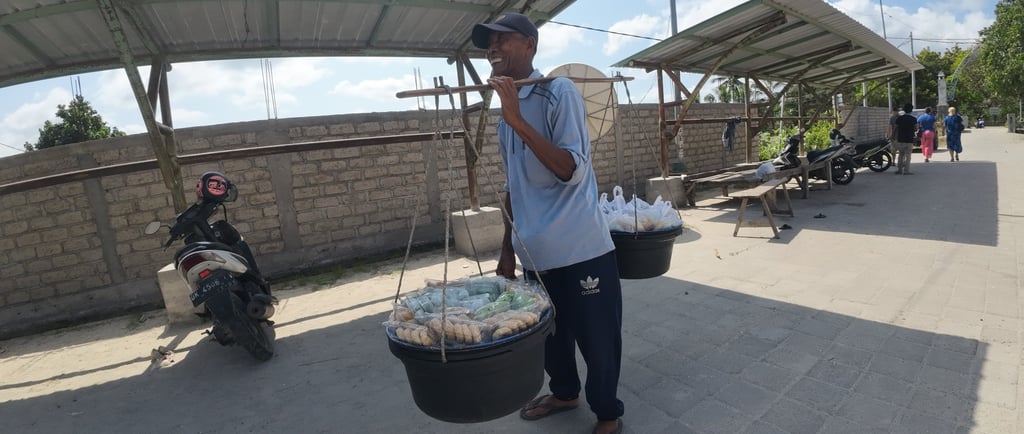Our guides speak English and German, Spanish, Dutch, France, Italian, Russian, Japanese, Arabic on request!
Discovering the Rich Heritage of Sade and Rambitan: Bali's Oldest Villages Worth Visiting
Lombok's traditional villages, such as Sade and Ende, offer a fascinating glimpse into the island's rich cultural heritage and the daily lives of the indigenous Sasak people. These villages are characterized by their unique architecture, featuring houses made from natural materials like bamboo and thatch, and are known for preserving age-old customs and crafts, including weaving and pottery. Visitors to these villages can experience authentic Sasak hospitality, witness traditional ceremonies, and gain insight into the community's harmonious relationship with nature.
Iwan Kur Kurniawan
1/23/20257 min read


Sade and Rambitan Traditional Village
The villages of Sade and Rambitan hold a prestigious place in the cultural tapestry of Bali, characterized by their rich heritage and historical significance. Situated in the district of Central Lombok, these villages are renowned for being among the oldest on the island, with roots tracing back to local traditions that have been preserved over the centuries. Both Sade and Rambitan are not only remarkable in their age but are also living examples of the unique customs and lifestyle of the Sasak people, the indigenous inhabitants of Lombok.
Sade village is particularly noted for its traditional architecture, with unique thatched-roof houses made from bamboo and palm leaves, designed to withstand the tropical climate. The architecture reflects a deep connection to the land and traditional practices, showcasing techniques that have been passed down through generations. On the other hand, Rambitan offers a glimpse into the intricate weaving techniques and craftsmanship that the Sasak people are famous for, including textiles that are imbued with cultural meaning and significance.
Historical Significance of Sade and Rambitan
The villages of Sade and Rambitan, situated in the heart of Lombok, reflect a rich tapestry of historical significance that stems from their formation and evolution over centuries. These villages are primarily inhabited by the Sasak people, an indigenous group whose culture and customs trace back to the early settlement of the region. Sade dates its origins to the 18th century, while Rambitan is believed to have been established around the same time, showcasing a long-standing heritage.
Throughout history, Sade and Rambitan have been pivotal in preserving the unique traditions of the Sasak community. The implementation of a communal lifestyle, characterized by intricate weaving practices and age-old agricultural techniques, underscores the villages' importance in the socio-economic structure of the area. The traditional houses, known as 'bale,' built with thatched roofs and bamboo walls, provide a glimpse into the architectural heritage of the region, enhanced by specific decorations that signify status and lineage.
Key historical events have also shaped the narrative of these villages. During the colonial period, Sade and Rambitan underwent significant changes, adapting to external influences while retaining their core traditions. As Bali experienced an influx of tourism in recent decades, both villages have strategically developed cultural tourism, allowing for greater interaction with visitors. This dynamic has prompted the preservation of indigenous practices such as the 'nyongkolan,' a traditional wedding ceremony, reflecting the ongoing commitment to cultural sustainability.
Today, Sade and Rambitan stand not only as historical enclaves but also as living museums that exhibit the continued vibrancy of Bali’s cultural heritage. The experiences offered by these villages allow for a deeper understanding of the Sasak way of life, providing insights into the significance of their customs, arts, and communal practices. The rich heritage of Sade and Rambitan is essential to appreciating the broader narrative of Bali’s diverse culture and societal evolution.
Cultural Traditions and Practices
The villages of Sade and Rambitan in Bali are rich in cultural traditions and practices that reflect the heritage and identity of the Sasak people. Traditional ceremonies are an integral part of daily life in these villages, serving to strengthen community ties and preserve ancestral beliefs. Ceremonial events, such as weddings, religious rites, and harvest festivals, are filled with vibrant rituals, rituals that involve intricate preparations and participation by entire families and the wider community.
The craft practices in Sade and Rambitan also highlight the cultural significance of preserving heritage. One of the most notable crafts is the traditional weaving of textiles, specifically ikat. The intricate designs involve a unique dyeing and weaving process that has been passed down through generations. Local women often gather in family groups to engage in this time-honored craft, promoting social cohesion while producing beautiful textiles that serve both decorative and functional purposes. The artistry involved showcases not only skill but also the cultural narratives inherent in the fabric designs.
Daily life in these villages is deeply intertwined with agriculture, as many inhabitants rely on farming for their sustenance. The farming methods employed are both traditional and sustainable, often featuring the cultivation of rice and other local crops. The villagers utilize intercropping and organic practices that respect the natural ecosystem. These agricultural techniques are not just means of survival; they embody a symbiotic relationship with the land, reinforcing the community's cultural identity.
Musical traditions also play a crucial role in the cultural landscape of Sade and Rambitan. Traditional Sasak music, often performed during ceremonies and celebrations, showcases the distinctive instruments and rhythms that characterize their cultural expression. Through these musical practices, the villagers convey stories, legends, and communal values, ensuring that their heritage continues to thrive across generations.
Architectural Features and Village Layout
The villages of Sade and Rambitan are significant for their unique architectural styles, which reflect the rich cultural heritage of the Sasak people. The traditional homes, known as "Lumbung," are not only functional but also carry deeply rooted symbolic meanings. Constructed primarily from natural materials such as bamboo and thatch, these dwellings exhibit a distinctive raised design. This elevated structure serves multiple purposes: it protects inhabitants from flooding and ensures that livestock remain safely housed beneath the floor. The roofs, steeply pitched and adorned with intricate carvings, reflect the artisanship of the local builders, showcasing the integration of aesthetics and practicality.
Beyond individual homes, the community structures reveal much about the social organization of Sade and Rambitan. Each village contains communal spaces designed for gatherings and festivals, reinforcing social bonds among residents. The "Bale Banjar," or village hall, stands as a focal point for communal decision-making and cultural events. Such spaces underscore the importance of community in Sasak society, where collective participation is pivotal in maintaining traditions and responsibilities.
The layout of these villages enhances their functionality and accessibility. Typically, both Sade and Rambitan are arranged in a linear pattern, with homes lining either side of a main path. This design facilitates easy movement and communication among residents while fostering a sense of unity. The spatial arrangement is further characterized by open spaces and rice fields, acknowledging the agriculture-based lifestyle that sustains these communities. As such, the architecture and village layout not only exemplify the artistic expression of the Sasak culture but also embody the practical needs and values of its people.
Experiences and Activities for Visitors
Visiting Sade and Rambitan offers a unique opportunity for travelers to immerse themselves in the vibrant culture and traditions of Bali's oldest villages. One of the primary ways to engage with local life is through guided village tours. These tours provide visitors with insights into the daily routines of village residents, allowing them to witness traditional farming techniques and harmonious coexistence with nature. Guides, often locals, are equipped with knowledge about the history and significance of various cultural practices, making each tour an educational experience.
Another enriching activity is the chance to participate in traditional ceremonies, which are an integral aspect of both Sade and Rambitan's cultural identities. Visitors may have the opportunity to join in on important rituals, such as weddings, cremations, or temple ceremonies. These events showcase vibrant local customs, music, and dance, providing a profound understanding of the Balinese worldview and its meanings. Engaging in these ceremonies fosters a deeper appreciation for the locality and strengthens connections with the community.
For those interested in craftsmanship, Sade and Rambitan also offer workshops where visitors can learn about traditional crafts, such as weaving and pottery. Participating in these hands-on activities allows guests to explore their creative skills while learning about the cultural significance behind each craft. Additionally, many locals engage in sustainable farming practices, and visitors have the chance to interact with farmers, gaining knowledge about the organic processes and traditional methods employed in rice cultivation and other agricultural produces. Experiences in these activities enhance visitors’ understanding of life in these Balinese villages and contribute to a richer travel experience.
Preservation Efforts and Challenges
Preserving the rich heritage of Sade and Rambitan, two of Bali's oldest villages, involves a concerted effort from the local communities, government agencies, and supportive organizations. The villagers of Sade and Rambitan actively engage in the conservation of their traditional customs, crafts, and architecture. The ongoing practices of these communities are integral to maintaining the cultural identity that makes these villages unique. Local artisans continue to produce traditional textiles and handicrafts, while communal rituals and ceremonies remain central to daily life. These practices not only serve as a means of cultural expression but also as an attraction for visitors keen on experiencing authentic Balinese traditions.
The role of the government is crucial in the preservation of cultural heritage. Initiatives have been launched to create awareness about the importance of sustainable tourism, which respects and integrates local customs. These efforts often include funding for infrastructure improvements and securing resources for cultural preservation projects. Workshops and educational programs have been established to further engage the community in protecting their heritage while adapting to modern needs.
Despite these positive endeavors, challenges persist. Rapid modernization and the influx of tourism pose significant threats to the traditional lifestyle and environment of Sade and Rambitan. Increased tourist activity can lead to the commercialization of culture, where traditions are altered to cater to visitor expectations. Additionally, the infrastructure developed for tourism can disrupt the social fabric of the communities. It is essential for visitors to approach these villages with respect, selecting authentic experiences that support local economies without compromising the cultural integrity.
The contributions of visitors can play a pivotal role in safeguarding the heritage of Sade and Rambitan. Tourists are encouraged to participate in community-run tours, purchase handmade crafts directly from artisans, and respect local customs and practices. Ultimately, fostering a symbiotic relationship between tourism and cultural preservation is vital to ensure that future generations can continue to embrace and celebrate the historic legacy of these enchanting Balinese villages.
Conclusion: Why Sade and Rambitan Should Be on Your Travel List
In exploring the vibrant cultural tapestry of Bali, Sade and Rambitan stand out as compelling destinations that offer an authentic glimpse into the island's heritage. These villages are not merely picturesque locales; they are living museums of Balinese culture, showcasing traditional practices, architecture, and community life that have been preserved through generations. Visitors seeking to deepen their understanding of Bali's rich history will find in Sade and Rambitan a truly enriching experience.
The unique charm of Sade, particularly with its traditional weaving, invites travelers to appreciate age-old crafts that reflect the dexterity and artistry of the Sasak people. Meanwhile, Rambitan, with its equally captivating culture and lifestyle, provides insights into the spiritual and communal aspects of Balinese life. Each village offers engaging interactions with local residents who are often eager to share their stories, customs, and the significance of their traditions, creating a memorable and immersive experience.
Furthermore, the scenery surrounding Sade and Rambitan enhances their allure, as visitors can enjoy the stunning landscapes typical of Bali, characterized by lush greenery and serene rice paddies. This natural beauty, coupled with the cultural richness, makes these villages essential stops on any Bali itinerary. Travelers who seek authenticity and depth in their explorations will find that Sade and Rambitan satisfy these desires, providing meaningful encounters with the island’s heritage.
Ultimately, when planning a journey to Bali, including Sade and Rambitan on your travel list is an excellent decision. These destinations not only offer a unique perspective on Balinese culture but also contribute to a greater appreciation of Bali's remarkable history and resilience. Embrace the opportunity to experience Bali beyond the surface, and allow Sade and Rambitan to enrich your understanding of this enchanting island.






